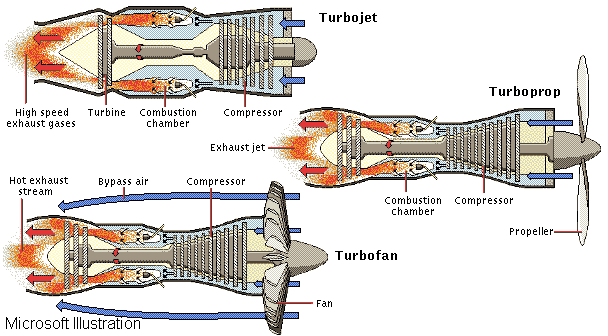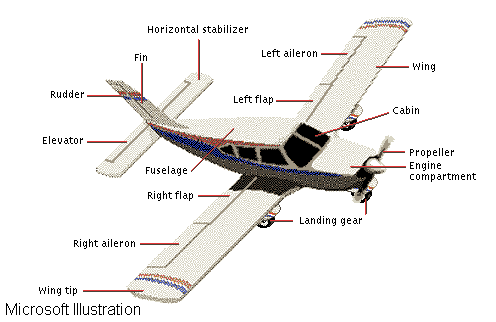
Copyright Microsoft Encarta
Since man first saw the birds, he has yearned to fly alongside them. Finally in 1903 Orville and Wilbur Wright made their first flight at Kitty Hawk, revolutionizing the world. Now, almost 90 years later, we have the ability to fly 3 times the speed of sound, at the edge of space. This page is dedicated to how.
The wing
The wing is curved on the top, and flat on the bottom. As the air goes across the top, it
has farther to go, and so has to speed up to meet up with the air on the bottom of the
wing, which does not have to go as far. This creates less air pressure on the top of the
wing, and the higher air pressure on the bottom pushes the wing up, creating lift, as long
as the aircraft maintains a certain speed.
Engines
There are 2 types of engines: Jet and Prop.
The prop uses the same principle as the car engine: It uses pistons to turn a crankshaft,
which, in turn, turns the prop. They are primarily used in small civilian aircraft.
Jets are a little more complicated:

Copyright Microsoft Encarta
The jet works by first compressing oxygen then by mixing it with a fine mist of fuel, which, when ignited, explodes. The exaust pushes on the sides of the combustion chamber, which equals out because of the sides. However, since there is no back to the combustion chamber, it pushes forward due to Newton's theory: "For every action there is an opposite and equal reaction" which pushes the engine and the plane forward.
Control Surfaces

Copyright Microsoft Encarta
The control surfaces are rather simple. The ailerons are on the end of
the wings, as in the diagram. They either raise or lower, increasing or decreasing lift.
They never go the same way; they are always opposite except in the neutral position. When
one end raises, it decreases the lift, and the other side lowers, increasing the lift on
that wing, causing the plane to roll.
The Elevators raise or lower the nose of the plane by creating or decreasing the lift on
the tail, where they are positioned. (see diagram). They always move the same way. If they
go up, it decreases the lift on the tail, raising the nose, and when they lower it
increases the lift, so the nose lowers.
The rudder is positioned on the tail, and causes the plane to yaw, or turn from side to
side without rolling. It is positioned on the vertical part of the tail, and when it goes
left or right it deflects the air and causes the plane to turn.
The Flaps increase the lift on the wings when lowered. They are used for landing and
take-off.